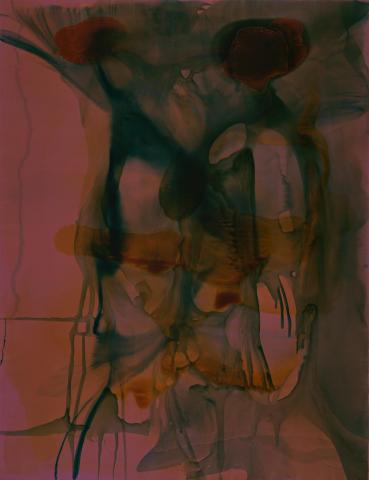VIEW FROM PRIVATE RICHARD CAPLICK RESERVE FROM THE KILLKIVAN ROAD TURNOFF TOWARDS THE NORTHWEST, 2003
DALE FRANK
varnish and synthetic polymer paint on canvas
260.0 x 200.0 cm
signed and dated twice verso: Dale Frank 2003
Roslyn Oxley9 Gallery, Sydney (label attached verso)
Private collection, Sydney
Dale Frank – Views from the Bruce Highway, Roslyn Oxley9 Gallery, Sydney, 19 March – 12 April 2003
Epic in both scale and intent, Dale Frank's sumptuously coloured, glossy canvases comprising his 'Views from the Bruce Highway' series offer a continually evolving dialogue upon the individual's relationship to the immersive universe. Featuring beautiful crystalline worlds suggestive of places that have been either macroscopically diminished or microscopically enlarged in scale, such works are landscapes in the purest form which investigate the very mechanics of looking. Significantly, there is no detachment of the viewer here through the use of a vantage point, no domination over a horizon. Rather, by engaging with science, poetics, spatialisation and time, Frank complicates the customary roles of artist as creator and audience as passive observer to powerfully highlight the problems inherent in the act of painting itself.
Typically featuring glistening, marbled flows and ponderous slides, slow-creeping bleeds and animated squiggles, these huge plasma-like abstractions possess a remarkable ability to completely absorb the viewer's consciousness and thus provoke powerful emotional responses akin to the medium of film. Yet despite the inordinately specific titles and the swirling tides of tinted varnish which seem to convey the forces of nature in a manner reminiscent of Romantic painting, Frank deliberately eschews any reference to the literal " his works are neither real nor imagined. Rather, each abstraction 'creates itself', evolving over time through the movement and chemical reactions between layers of strident, pulsating varnish in its molten liquid form ('a living entity'). Indeed, for Frank, the blank white canvas is never a pristine ground that must be filled, but 'a black space' where the final outcome is 'forced upon the Painting by the vagaries of its own Nature and makeup: its environment and 'material' personality determine its image, its future, its relations within the world.'1
If Frank's technique appears ostensibly random or unpredictable, such spontaneity belies a painstaking process of 'endurance and isolation'. As the luminous pools of pigmented varnish are poured onto the horizontal canvas and immediately begin to resist and coalesce, the artist must remain continuously attentive to the passing of time, the variations of climate, and the actions required by him at every stage - adding more varnish or changing the angle of support as necessary. As Frank reveals, 'It is a totally hands on and cerebral way of painting' The process can take up to twenty-four hours where I have to be permanently standing over the painting, constantly considering every minute aspect.'2
With his visionary eloquence and technical ingenuity, Frank occupies an esteemed position at the forefront of Australian contemporary art practice. Awarded the prestigious Red Cross Art Award by John Olsen at the tender age of 16, his was a precocious talent and within only five years, he had achieved international recognition with solo exhibitions across Australia, Europe and America. Significantly, in 1983, his work was selected for show alongside Thomas Lawson and Anselm Kiefer at the Museo Palazzo Lanfranchi in Pisa, Italy, and in 1984, he was included in the Aperto section of the Venice Biennale. In 2000, the Museum of Contemporary Art, Sydney mounted the touring survey exhibition of his work Ecstasy: 20 years of painting; in 2005, Frank won the Arthur Guy Memorial Painting Prize at the Bendigo Art Gallery, Victoria and in 2007, his achievements were documented in the magnificent monograph So Far - The Art of Dale Frank 2005 - 1980. Today, his paintings are held in every major public collection across Australia, as well as numerous private and corporate collections around the world.
1. Frank, D., quoted in Chapman, C., 'Dale Frank: Performance into Painting' in Frank, D., So Far the Art of Dale Frank 2005-1980, Schwartz City Publishing, Melbourne, 2008, p. 134
2. Frank cited in Crawford, A., 'Dale Frank', Art & Australia, vol. 42, no. 2, Sydney, 2004, p. 214
VERONICA ANGELATOS
